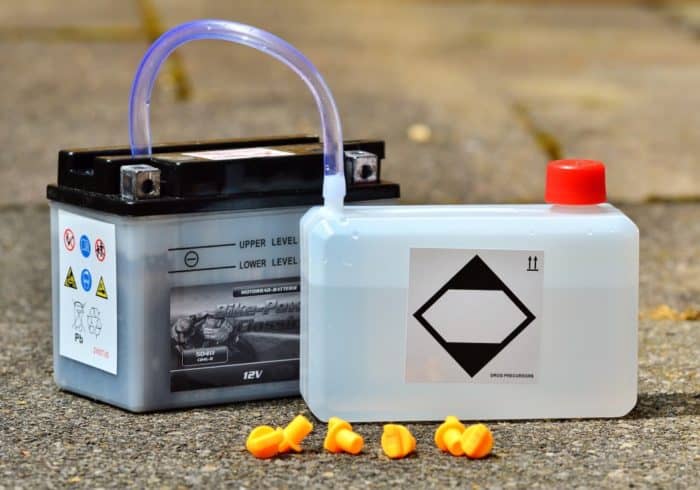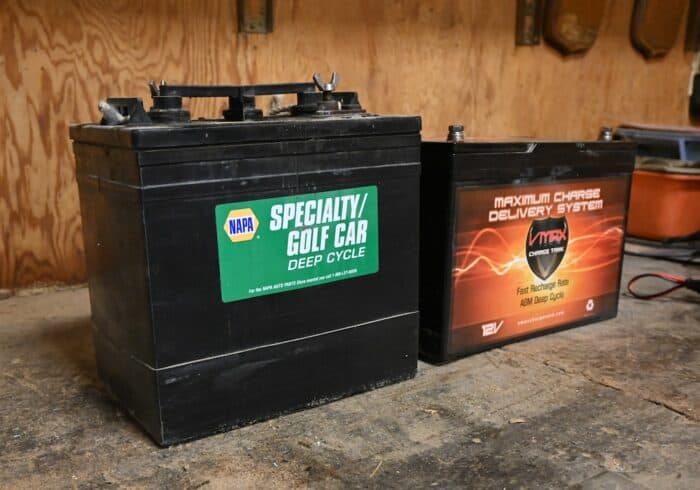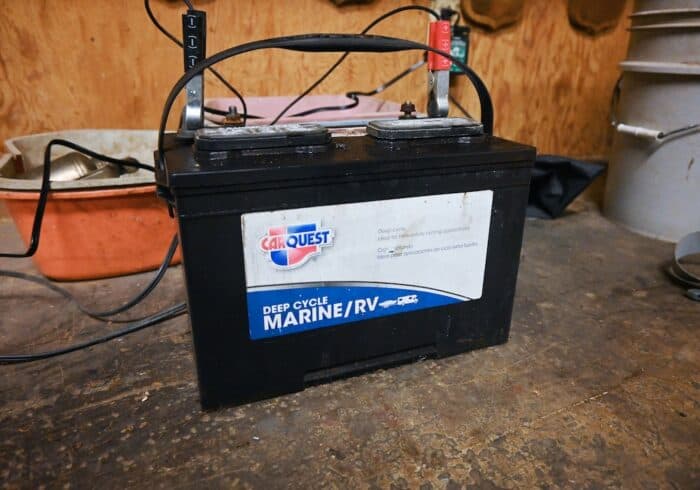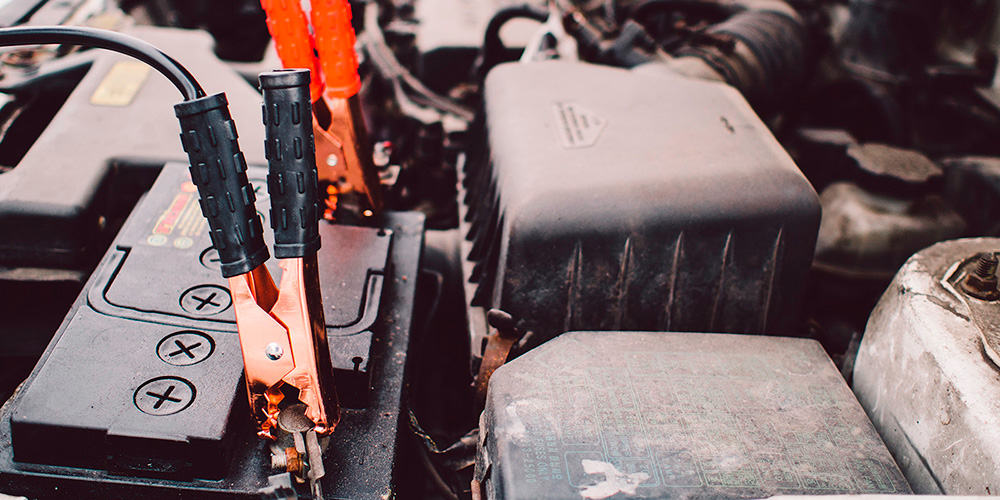What Is Equalizing Batteries?
If your RV or vehicle’s flooded lead-acid batteries need to be charged constantly or drain faster than they should, you might be able to fix them by equalizing the batteries.
When allowed to sit without any charge for extended periods, the acid in the RV batteries can separate from the water and collect at the bottom of the cells. This is called “Stratification.”
Related Product: Keep your RV and other batteries charged using the highly recommended NOCO Genius 1 (click to view on Amazon)
When left too long, the collected acid will start to corrode and damage the inner battery plates, which over time decreases the battery’s ability to hold a charge.
Equalizing batteries is a way to remix the sulfates with the water inside the battery. It can also help remove built-up sulfates from the plates inside the batteries.
Regular equalizing will keep your deep cycle RV batteries or regular flooded lead-acid batteries healthy longer and could fix problems you may already be experiencing.
Note: equalizing can only be done on flooded lead-acid batteries that are not sealed like AGM.
Related: Best Deep Cycle Battery Chargers Reviewed (12V, 6V, RV, AGM)
What Happens During Battery Equalization?
In order to start the equalization process, a higher amount of voltage than normal is charged into the flooded lead-acid batteries.
The acid will boil, which mixes the acid and the water, reversing stratification.
Also, much of the sulfates collected on the plates from regular discharging will come off, which increases the battery’s capacity to hold a charge.
It’s normal for the batteries to get warm during an equalization cycle.
If you look at the acid inside the cells of the batteries, it will be bubbling and turn a milky white from the gas.
See Also: Best Deep Cycle RV Batteries (AGM, SLA, 12V, 6V)

What You Will Need To Equalize Your RV Deep Cycle Batteries
A Battery Charger
The first thing you need to check is the inverter in your RV or trailer. They will sometimes have an equalizer mode, so you won’t need to use an external battery charger.
If you don’t have an equalizer mode or an inverter, you can use a battery charger that has an equalizer mode (often called “repair mode”) or you can use a regular battery charger if that’s all you have.
Even small battery chargers like the NOCO Genius 1 (click to view on Amazon), can have a repair mode.
Battery Hydrometer
Use a Hydrometer (Click to view on Amazon) to check the density of the electrolytes in each cell so you know the equalizing is working and to prevent overcharging.
This is also called a specific gravity test. It’s highly recommended to use one when equalizing batteries.
Safety Gear (Gloves, Goggles, Clothing That Covers Your Arms and Legs)
You are going to be opening the caps to your flooded lead-acid batteries and working with battery acid.
It can burn holes in your clothes and is very dangerous if it gets on your skin or in your eyes. Make sure you wear old clothes that cover your arms and legs and sturdy shoes.
You will need thick gloves that you won’t mind throwing away after and safety glasses or goggles.
Related: When To Charge A Deep Cycle Battery
If you get battery acid in your eyes, immediately flush them out with lukewarm water for 15-20 minutes.
It’s important to keep rinsing them to get the acid out. If stinging, blurred vision, or pain persists, flush them again and/or go to the emergency room.
If you get battery acid on your skin, do the same procedure of rinsing the affected area under running water for at least 15 minutes.
Distilled Water
You want your RV or car batteries to have the right amount of water in them before and after equalization.
There may be some water lost during equalization. You should fill the battery cells before and after using clean distilled water.
Wire Brush & An Old Rag
The top of your RV battery needs to be cleaned before you open the cells so no dirt gets inside. The posts and connections need to be clean and acid-free as well, for a good charge.
Use an old rag with some water to wipe off the battery and a wire brush to remove any discharge on the battery posts and connectors.
Some people recommend using baking soda to remove the acid built up on the battery, but if any gets into the cells of your battery it will ruin it.
It’s much safer to just use a wire brush and a wet rag to clean the battery.
See Also: Best Portable Quiet Inverter Generators For RV Camping

Pre Battery Equalization Procedure
There are a few things you need to do before running the equalization on your RV deep cycle batteries.
These are also basic maintenance procedures you can do monthly to help extend the life of your RV deep cycle or car flooded lead-acid batteries.
Reminder: Only Flooded Lead-Acid Batteries can be equalized. Do Not equalize Lithium, Gel, or AGM batteries.
- Make sure the batteries are fully charged and in a covered but well-ventilated area. (Leaving the storage door on your RV will be good enough) If you have them in your garage, make sure your car is not parked close by. The battery acid can destroy the paint job.
- Disconnect everything from batteries so they are receiving no charge and losing no charge.
- Let the batteries sit in this “rest mode” for 30 minutes. This will ensure you get an accurate reading from your hydrometer.
- Put on gloves and protective eyewear.
- Clean posts and top of batteries with old wet rag and wire brush. Throw away the rag after use.
- Remove all the caps from flooded lead-acid battery cells.
- Put the tube end of the hydrometer into an open cell of the battery.
- Once the Hydrometer is in the battery’s acid, slowly release the bulb end to draw liquid into the hydrometer. Do this 2-3 times to rinse the acid in the hydrometer. Then take a reading. You need enough liquid support float, but not so much that it fills the entire hydrometer.
- A perfect reading will be between 1275 and 1300. If you are testing batteries that won’t hold a charge, the reading will most likely be far below the 1300 line. Record the reading so you can compare after equalizing your RV batteries.
- After taking the reading, squeeze all the acid back into the cell. Never transfer acid from one cell to another.
- Measure and record the hydrometer’s gravity reading in every cell.
- Next, make sure the level of acid is right in each cell. There should be a marker to indicate the correct level, which will be about half an inch below the top of the battery. Never fill the cell so it’s completely full. Overfilling will cause the battery to leak acid and corrode everything around it. Also, never allow the acid level to go below the plates inside. This will damage your batteries and cause them to lose their charge holding ability.
- If the liquid levels are low, add distilled water to bring them up to the proper level. (remember to keep your gloves and eye protection on)
- Replace all the caps on the cells of the batteries.
- If you are going to be using your RV or solar system inverters equalizer mode, you can reconnect the batteries to the RV. If you are using a charger, you can connect the battery to the charger.
See Also: Best Portable Solar Panel Charger For RV Camper/Boondocking
How To Equalize RV Batteries with RV or Solar Inverter
Some RV and travel trailers have an equalization mode on their inverter. Even some solar panel inverters will have an equalization mode.
It’s not as simple as just turning it to equalize. There are a few precautionary steps you will want to take first.
If you are using your solar panel system, make sure you have enough hours of sunlight to run the charge for at least 4 hours.
Reminder: Only Flooded Lead-Acid Batteries can be equalized. Do Not equalize Lithium, Gel, or AGM batteries.
- Make sure batteries are fully charged.
- Make sure the main power to the RV refrigerator, furnace, and AC is turned off. You can do this by pulling their fuses. If you have any other sensitive 12 volt appliances, disconnect them from power as well. (if your RV or trailer has a battery disconnect switch, turn your batteries off.)
- Now you can turn on the battery equalize mode.
- The equalize cycle will normally run for around 4 hours
- Once the equalization is complete, you can follow the “Post Equalization Procedure” found below.

How To Equalize A Battery with a Battery Charger
If your RV or travel trailer does not have an equalization mode on the inverter or you don’t even have an inverter, you can use a battery charger.
Some high-tech battery chargers like the NOCO Genius 1 (click to view on Amazon) have an equalize or “repair” mode already programmed in.
See Also: Best Deep Cycle Battery Chargers Reviewed (12V, 6V, RV, AGM)
If your battery charger does not have a repair mode, you need to set it to charge 10% higher than the recommended charge voltage of the battery you want to equalize.
For example, a 12-volt battery needs to be charged at a minimum of 14.4 volts and a maximum of 15.5 volts to equalize.
If you have a very simple battery charger that’s not adjustable, you may be able to simply unplug it after it charges your battery fully, then plug it in again for a few hours to equalize it.
This method may not work as well as a charger you can adjust the volts on or one with an equalizer mode, but it should help a little.
Reminder: Only Flooded Lead-Acid Batteries can be equalized. Do Not equalize Lithium, Gel, or AGM batteries.
- Make sure the battery is fully charged and disconnected from your RV or car so no 12-volt appliances can be damaged.
- Start the equalize or “repair” mode on your charger. On a charger with no equalizer mode, adjust the volts to the recommended value I discussed in the paragraph above. Start charging for 1-4 hours. If you are using a simple battery charger, unplug it and plug it back in so it charges the battery again. Let it charge for 1-4 hours.
- Let the batteries equalize for around 4 hours or you can take another step and take a gravity reading every hour. You do this by running the charge for an hour, then let the battery sit for an hour to cool down. Take the reading after the battery has cooled down. Then repeat the hour on hour off process. When the readings become constant and stop raising, the battery is fully equalized.
- If you don’t take readings every hour, you can simply run the equalizing charge for around 4 hours.
- Once you’re done with the equalizing charge, you can start the “Post Equalization Procedure” found below.
See Also: Best Portable Power Station/Solar Generator For Camping
Post Battery Equalization Procedure
Now that you’ve run the equalization charge, it’s now time to check the gravity readings and refill depleted cells.
- Disconnect everything from batteries so they are receiving no charge and losing no charge.
- Let the batteries sit in this “rest mode” for 30 minutes. This will ensure you get an accurate reading from your hydrometer.
- Put on gloves and protective eyewear.
- Remove the caps from the batteries.
- Take the specific gravity readings with your hydrometer from each battery cell and compare them with the readings taken before equalization. If there is little to no change, you can run the equalization again, but it may be a sign that your battery is damaged or too old to be repaired.
- If equalization has worked, you should get a higher reading than you did before.
- Check the levels of water in each cell and refill if necessary. Some acid may have evaporated during the boiling time.
- Replace all the caps on your flooded lead-acid batteries.
- When reconnecting your RV, travel trailer or car to your batteries now is a good time to put anti-corrosion grease like NOCO NCP2 (Click to view on Amazon) on the terminals to keep them from building up acid discharge again.
- Congrats, you have now successfully maintained and equalized your flooded lead-acid batteries.
See Also: Best Portable Foldable Solar Panel Chargers For Camping

Frequently Asked Questions About Battery Equalization
How often should I equalize the batteries in my RV or car?
Deciding on how often you will maintain and equalize the flooded lead-acid deep-cycle batteries in your RV depends on how often you use them.
You should always equalize them before and after a storage period, but monthly equalization is recommended if you take them below a 50% charge regularly.
This is because sulfate collects on the battery plates when below 50% charge and you will need to remove the sulfates often so they don’t corrode the plates in your deep-cycle RV battery.
Car batteries will rarely go below a 50% charge and you will only need to equalize them if your battery sits for a long time with a low charge.
If you are going to put your vehicle in storage for even a few weeks, take the battery or batteries out and keep them charged using a smart battery charger that will not overcharge the battery.
Can I do a gravity test on my batteries while they are charging?
Gravity testing your flooded lead-acid while they are charging will not give you an accurate reading.
If you are testing your batteries every hour to see when the equalization process is done, make sure you let the batteries cool with no charge for about an hour before taking a gravity test.
Once you’ve taken the test, you can start the charge again. This will give you an accurate reading.
What can I do to decrease the need for equalizing my RV batteries?
- Don’t let your batteries fall below a 50% charge. Flooded lead-acid batteries build up sulfate when the charge falls below 50%. Lithium batteries can go down to 20% before they get damaged, which is why Lithium batteries are becoming more popular in the camping world.
- Keep a small charge on the batteries when in storage. This will ensure the battery’s charge doesn’t fall below 50% and it will also keep the acid from going into stratification.
See Also: Best 12 Volt RV Lithium Battery Reviews + How To Charge
Will shaking the batteries help re-mix the acid?
There is a theory that driving regularly with your RV batteries will keep the acid mixed. It could be true, and if you’re driving your RV around, you are most likely using your batteries and keeping them charged.
If your batteries have been dead for a long time and the water and acid have completely separated, driving around with them in your car or shaking them won’t help much.
The only way to fix it will be to run an equalization charge.
What does a hydrometer measure?
I’ve been talking a lot about using a hydrometer to measure the specific gravity of your batteries, but what exactly is the hydrometer measuring?
The liquid in the cells of flooded lead-acid batteries is around 65% water and 35% sulfuric acid. The more charge a battery has, the more sulfur there will be in the liquid solution.
As a battery loses charge, the sulfur moves towards the plates. That’s why sulfur collects and gets stuck on the plates inside a lead-acid battery when it’s below 50% charge. (this is also true for Gel and AGM batteries)
Sulfur collecting on the plates is a bad thing because it breaks them down and causes the battery to lose its ability to hold a full charge.
When you equalize a battery and remove the sulfur collected on the plates, the battery will gain back some of its charge capacity.
The liquid in a battery has a higher gravity pull when there’s more sulfur in the solution.
That’s why you can tell if the mixture has the right amount of sulfur in it by how much gravity is being drawn on the float of the hydrometer.
Temperature can affect the specific gravity reading. A battery is fully charged when it’s 1.265 at 80°F.
To get the most accurate reading to add .004 for every 10°F it is above 80°F and subtract .004 for every 10°F it is below 80°F.
I rarely mention doing heat addition or subtraction for equalizing an RV battery because the change is small, and it’s not super important to get the most accurate reading when you are equalizing.
If you let the batteries rest between charges, you will get a fairly accurate reading anyway.
Click to see Hydrometer on Amazon
Do you equalize Gel, AGM, or Lithium Batteries?
No! Equalization is for flooded lead-acid batteries only.
Running an equalizing charge on these kinds of batteries will overcharge them and damage them.
Does putting batteries in series equalize them?
No, you need to have a much higher charge on batteries in order to equalize them, and simply connecting a battery to another one will not increase the charge enough to equalize or “boil” it.
Can you equalize multiple batteries at the same time (Batteries in a series)?
Yes, you can. It’s recommended to connect the charger to the healthiest battery in the series.
You can do this by measuring the gravity of each battery when they are fully charged and the one with the highest gravity will be the one you connect the charger to.
If you have the time and only a few batteries, it might be more effective to equalize them one at a time. For relatively healthy batteries, you can equalize them in series.
How to tell if batteries are flooded lead-acid.
It will normally say on the battery if it is a flooded lead-acid. You can also tell by looking for the caps to the cells.
These will normally be round twist caps or a rectangular piece that is capping multiple cells at one time.
If it’s very difficult to remove, it’s not a cap. Don’t force anything open as it could get battery acid everywhere and harm you.
If there aren’t any caps, then you may have a sealed (SLA) or valve-regulated lead-acid battery like a gel or AGM. These cannot be equalized.
Related: Which iPhone Has The Best Battery Life
Have any more questions about equalizing flooded lead-acid batteries? Leave a comment below.

